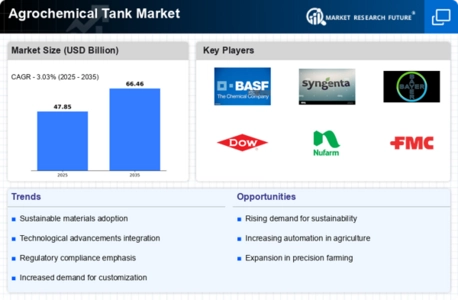Innovations in Tank Design
Innovations in tank design are playing a crucial role in the Agrochemical Tank Market. Manufacturers are increasingly focusing on developing tanks that are not only durable but also equipped with advanced features such as corrosion resistance and enhanced safety mechanisms. These innovations are essential for meeting the stringent requirements of agrochemical storage and handling. For instance, the introduction of double-walled tanks and integrated monitoring systems has improved safety and efficiency in the storage of hazardous materials. As the agrochemical market continues to expand, the demand for innovative tank solutions is expected to grow, potentially leading to a market increase of around 5% annually over the next few years. This trend highlights the importance of technological advancements in shaping the future of the Agrochemical Tank Market.
Increasing Regulatory Standards
The Agrochemical Tank Market is significantly influenced by increasing regulatory standards aimed at ensuring environmental safety and public health. Governments and regulatory bodies are implementing stricter guidelines for the storage and handling of agrochemicals, necessitating the use of compliant tank solutions. These regulations often require tanks to meet specific safety and environmental criteria, which can drive up demand for high-quality, certified tanks. As a result, manufacturers are compelled to innovate and enhance their product offerings to comply with these regulations. The market for compliant agrochemical tanks is projected to grow as more countries adopt stringent regulations, potentially leading to a market expansion of approximately 4% annually. This trend underscores the critical role of regulatory compliance in shaping the Agrochemical Tank Market.
Rising Demand for Crop Protection
The Agrochemical Tank Market is experiencing a notable increase in demand for crop protection solutions. As agricultural practices evolve, farmers are increasingly reliant on agrochemicals to enhance yield and protect crops from pests and diseases. This trend is driven by the need to ensure food security amidst growing populations. According to recent data, the agrochemical sector is projected to reach a valuation of approximately USD 300 billion by 2026, indicating a robust growth trajectory. Consequently, the demand for agrochemical tanks, which are essential for the safe storage and transportation of these chemicals, is likely to rise significantly. This growing reliance on agrochemicals underscores the importance of efficient and reliable tank solutions in the Agrochemical Tank Market.
Expansion of Agricultural Activities
The expansion of agricultural activities is a key driver for the Agrochemical Tank Market. As more regions adopt modern farming techniques and increase their agricultural output, the demand for agrochemicals is likely to rise correspondingly. This expansion is particularly evident in developing regions where agricultural practices are being modernized to improve productivity. The agrochemical market is projected to grow at a compound annual growth rate of approximately 3.5% through 2026, which will subsequently boost the demand for agrochemical tanks. These tanks are essential for the safe storage and application of agrochemicals, making them a critical component in the agricultural supply chain. The growth in agricultural activities thus presents a substantial opportunity for the Agrochemical Tank Market.
Sustainability and Eco-Friendly Practices
Sustainability and eco-friendly practices are becoming increasingly important in the Agrochemical Tank Market. As environmental concerns rise, there is a growing emphasis on using sustainable materials and practices in the production and use of agrochemical tanks. Manufacturers are exploring options such as recyclable materials and energy-efficient production processes to minimize their environmental footprint. This shift towards sustainability is not only driven by consumer demand but also by regulatory pressures to reduce environmental impact. The market for eco-friendly agrochemical tanks is expected to witness a growth rate of around 6% over the next few years, reflecting the industry's commitment to sustainable practices. This trend indicates a significant transformation within the Agrochemical Tank Market, as stakeholders prioritize environmental responsibility.



.webp)
.webp)
.webp)
.webp)
.webp)
.webp)








Leave a Comment